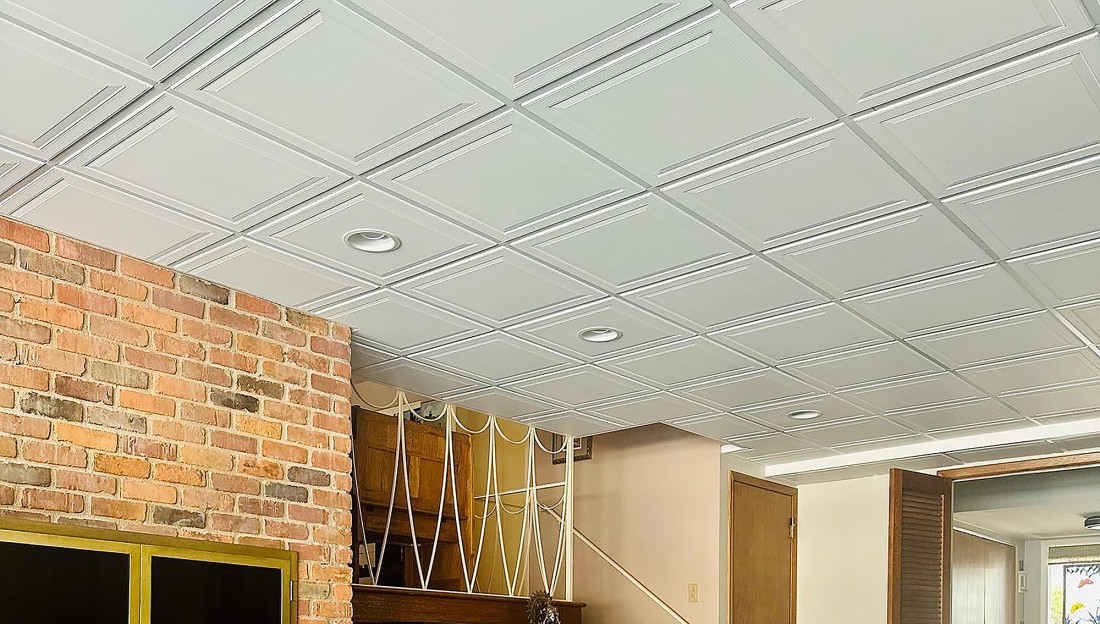 When it comes to finishing a basement, homeowners often focus on flooring, lighting, and layout—but the ceiling plays a critical role in the comfort, function, and future maintenance of the space. While there are several options available—drywall, painted exposed ceilings, and drop ceilings—one solution stands out for basements: drop ceilings, also known as acoustic ceilings.
When it comes to finishing a basement, homeowners often focus on flooring, lighting, and layout—but the ceiling plays a critical role in the comfort, function, and future maintenance of the space. While there are several options available—drywall, painted exposed ceilings, and drop ceilings—one solution stands out for basements: drop ceilings, also known as acoustic ceilings.
Here’s why drop ceilings are the best choice for most basements—and how they compare to the other options.
✅ The Case for Drop Ceilings (Acoustic Ceilings)
What It Is:
A suspended grid system with removable tiles made of sound-absorbing materials, installed below your existing floor joists.
Why It’s the Best:
Easy Access to Utilities
Plumbing leaks? Electrical upgrades? HVAC repairs? Just pop a tile. With a drop ceiling, you don’t have to tear open drywall or damage your finished space to make repairs or improvements.
Excellent Sound Control
Acoustic tiles are designed to absorb sound. This makes your basement quieter—and keeps noise from traveling to the rest of the house, which is a major plus if you're using it as a media room, bedroom, or office.
Moisture Resistance
Basements can be humid or even damp. Acoustic tiles are available in moisture- and mold-resistant varieties, offering peace of mind that drywall simply can’t match.
Modern Designs Available
Forget the old “office ceiling” look. Today’s tiles come in sleek, stylish patterns that can blend beautifully into a modern home.
Quick Repairs & Upgrades
If a tile ever gets damaged or stained, replacing it takes minutes—no patching, sanding, or painting required.
Ideal For:
Multi-use basements
Homes with plumbing, ductwork, or wiring overhead
Homeowners who want long-term flexibility
???? Why Drywall Falls Short in the Basement
Drywall ceilings are common upstairs—but in basements, they can create problems.
The Drawbacks:
No Access to Utilities
Once it’s up, it’s sealed. Any repairs to electrical or plumbing behind it require cutting holes—then re-mudding, sanding, and repainting.
More Labor-Intensive
Drywall requires framing, hanging, taping, mudding, sanding, and painting. It’s messier and slower to install.
Risk of Damage
A minor water leak can lead to major damage, forcing you to replace large sections of the ceiling.
Best For:
Basements with zero overhead systems
Homeowners prioritizing a smooth, finished look and willing to sacrifice future flexibility
???? What About Just Painting the Ceiling?
Painting an exposed ceiling black or white is a cost-effective way to leave joists, ductwork, and pipes visible—often used to create an “industrial” or “loft” look.
The Trade-Offs:
Lack of Sound Insulation
Painted ceilings offer no sound absorption, making the space echo and increasing noise upstairs.
Unfinished Feel
This style isn’t for everyone. It can look great in a gym or game room but may not suit a family space or home theater.
Dust & Maintenance
Open joists collect dust, cobwebs, and debris, requiring regular cleaning.
Best For:
Budget projects
Industrial-style designs
Utility or storage areas
The Bottom Line: Drop Ceilings Deliver the Most Value
Need/Concern Best Choice
Access to Pipes & Wires ✅ Drop Ceiling
Noise Control ✅ Drop Ceiling
Moisture Resistance ✅ Drop Ceiling
Modern, Finished Look ✅ Drop Ceiling
Budget Aesthetic Option Painted Exposed Ceiling
Seamless Look (No Access) Drywall Ceiling
If you're finishing your basement, it's important to think not just about how it looks today, but how it will serve you in the years to come. For the best balance of function, durability, style, and sound control, drop ceilings are the smart, flexible choice.
Ready to upgrade your basement with a ceiling that looks great and works hard?
At Impressive Basements, we install high-quality acoustic ceiling systems that transform your lower level into a functional, finished space—while keeping future access and comfort in mind.
